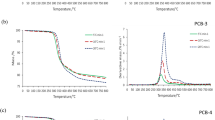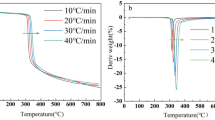Abstract
Introduction
The pyrolytic method was employed to recycle metals and brominated compounds blended into printed circuit boards (PCBs).
Methods
PCBs were crushed into pieces 4.0–4.8 mm in size, and the crushed pieces were pyrolyzed at temperatures ranging from 200 to 500°C. The compositions of pyrolytic residues, liquid products, and exhaust were analyzed by inductively coupled plasma atomic emission spectrometer, inductively coupled plasma mass spectrometry, and gas chromatography–mass spectrometry. Pyrolytic exhaust was collected by an impinger system in an ice bath cooler to analyze the composition fraction of the liquid product, and uncondensable exhaust was collected for gas constituent analysis.
Results
Phenol, methyl-phenol, and bromo-phenol were attributed mainly to the liquid product. Metal content was low in the liquid product. In addition, CO, CO2, CH4, and H2 were the major components of pyrolytic exhaust.
Conclusions
Brominated and chlorinated compounds—i.e., dichloromethane, trans-1,2 dichloroethylene, cis-1,2 dichloroethylene, 1,1,1-trichloroethane, tetrachloromethane, bromophenol, and bromoform—could be high, up to the several parts per million (ppm) level. Low molecular weight volatile organic compounds (VOCs)—i.e., methanol, acetone, ethyl acetate, acrylonitrile, 1-butene, propene, propane, and n-butane—contributed a large fraction of VOCs. The concentrations of toluene, benzene, xylene, ethylbenzene, and styrene were in the ppm range.



Similar content being viewed by others
References
Allian A, Sansoni B (1985) A review on activation analysis of air particulate matter. Radioanal J Nucl Chem 89:191–275
Balabanovich AI, Hornung A, Merz D, Seifert H (2004) The effect of a curing agent on the thermal degradation of fire retardant brominated epoxy resins. Polym Degrad Stabil 85:713–723
Barontini F, Cozzani V, Marsanich K, Raffa V, Petarca L (2004a) An experimental investigation of tetrabromobisphenol A decomposition pathways. J Anal Appl Pyrolysis 72:41–53
Barontini F, Marsanich K, Petarca L, Cozzani V (2004b) The thermal degradation process of tetrabromobisphenol A. Ind Eng Chem Res 43:1952–1961
Barontini F, Marsanich K, Petarca L, Cozzani V (2005) Thermal degradation and decomposition products of electronic boards containing BFRs. Ind Eng Chem Res 44:4186–4199
Blazsó M, Zs C, Cs C (2002) Pyrolysis and debromination of flame retarded polymers of electronic scrap studied by analytical pyrolysis. J Anal Appl Pyrolysis 64:249–261
Byers TJ (1991) Printed circuit board design with microcomputer. McGraw-Hill, New York, USA
Chen KS, Yeh RZ (1996) Pyrolysis kinetics of epoxy resin in a nitrogen atmosphere. J Hazard Mater 49:105–113
Chen KS, Yeh RZ, Wu CH (1997) Kinetics of thermal decomposition of epoxy resin in nitrogen-oxygen atmosphere. J Environ Eng-ASCE 123:1041–1046
Chen KS, Chen HC, Wu CH, Chou YM (1999) Kinetics of thermal and oxidative decomposition of printed circuit boards. J Environ Eng-ASCE 125:277–283
Chien YC, Wang HP, Lin KS, Huang YJ, Yang YW (2000) Fate of bromine in pyrolysis of printed circuit board wastes. Chemosphere 40:383–387
Clean Japan Center (2002) Tokyo, Japan: Recycling-Oriented Society.
Friedman HL (1964) Kinetics of thermal degradation of char-forming plastics from thermogravimetry: application to a phenolic plastics. J of Polym Sci Ser C 6:183–195
Grabda M, Oleszek-Kudlak S, Rzyman M, Shibata E, Nakamura T (2009) Studies on bromination and evaporation of zinc oxide during thermal treatment with TBBPA. Environ Sci Technol 43:1205–1210
Grause G, Furusawa M, Okuwaki A, Yoshioka T (2008) Pyrolysis of tetrabromobisphenol-A containing paper laminated printed circuit boards. Chemosphere 71:872–878
Hall WJ, Williams PT (2007) Processing waste printed circuit boards for material recovery. Circuit World 33:43–50
Hornung A, Donner S, Balabanovich A, Seifert H (2005) Polypropylene as a reductive agent for dehalogenation for brominate organic compounds. J Clean Prod 13:525–530
Kang HY, Schoenung JM (2005) Electronic waste recycling: a review of U.S. infrastructure and technology options. Resour Conserv Recycl 45:368–400
Lassen C, Lokke S (1999) Brominated flame retardants substance flow analysis and assessment of alternatives. Danish Environmental Protection Agency, Copenhagen, Denmark
Lee SM (1989) Dictionary of composite materials technology. Technomic Publishing Company Inc., Pennsylvanias, USA
Lee CH, Chang SL, Wang KM, Wen LC (2000) Management of scrap computer recycling in Taiwan. J Hazard Mater A 73:209–220
Lee CH, Chang CT, Fan KS, Chang TC (2004) An overview of recycling and treatment of scrap computers. J Hazard Mater B 114:93–100
Lee JC, Song HT, Yoo JM (2007) Present status of the recycling of waste electrical and electronic equipment in Korea. Resour Conserv Recycl 50:380–397
Luda MP, Balabanovich AI, Camino G (2002) Thermal decomposition of the retardant brominated epoxy resins. J Anal Appl Pyrolysis 65:25–40
March J (1992) Advanced organic chemistry: reactions, mechanisms, and structure, 4th edn. John Wiley & Sons, New York
Marsanich K, Zanelli S, Barontini F, Cozzani V (2004) Evaporation and thermal degradation of tetrabromobisphenol A above the melting point. Thermochim Acta 421:95–103
National Safety Council (1999) Electronic product recovery and recycle baseline report. Washington, DC, USA
Richter H, Lorenz W, Bahadir M (1997) Examination of organic and inorganic xenobiotics in equipped printed circuits. Chemosphere 35:169–179
Tohka A, Lehto H (2005) Mechanical and thermal recycling of waste from electric and electrical equipment. Helsinki University of Technology, Espoo, Finland
United State Environmental Protection Agency (U.S. EPA) (1997) Measurement of Gaseous Organic Compound Emission by Gas Chromatography-Method 18; Code of Federal Regulation, Part 60. Subpart TTT; Government Printing Office, Washington, DC, USA
U.S. EPA (2008) Partnership to evaluate flame retardants in printed circuit boards. Cincinnati, Ohio
Vasile C, Brebu MA, Karayildrim T, Tanik J, Darie H (2007) Feedstock recycling from plastics and thermosets fractions of used computers. II. Pyrolysis oil upgrading. Fuel 86:477–485
Viet HM, Bernardes AM, Ferreira JZ, Tenório JAS, Malfatti CF (2006) Recovery of copper from printed circuit boards by mechanical processing and electrometallurgy. J Hazard Mater B137:1704–1709
Wang CF, Chin CJ, Luo SK, Men LC (1999) Determination of chromium in airborne particulate matter by high resolution and laser ablation inductively coupled plasma mass spectrometry. Anal Chim Acta 39:257–266
Yan FL (1998) Metals recovery from scrap IC board. Energy Resource Laboratory.
Author information
Authors and Affiliations
Corresponding author
Additional information
Responsible editor: Alvin Lee Young
Electronic supplementary materials
Below is the link to the electronic supplementary material.
ESM1
(DOC 27 kb)
Rights and permissions
About this article
Cite this article
Chiang, HL., Lo, CC. & Ma, SY. Characteristics of exhaust gas, liquid products, and residues of printed circuit boards using the pyrolysis process. Environ Sci Pollut Res 17, 624–633 (2010). https://doi.org/10.1007/s11356-009-0245-y
Received:
Accepted:
Published:
Issue Date:
DOI: https://doi.org/10.1007/s11356-009-0245-y




